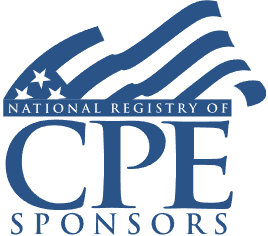Audits of Pooled Employer Plans (PEPs): SECURE Act's New Flexible Retirement Plan
Documentation, Testing, and Design Considerations; Efficiency and Pricing

Course Details
- smart_display Format
On-Demand
- signal_cellular_alt Difficulty Level
Intermediate
- work Practice Area
Accounting
- event Date
Thursday, April 24, 2025
- schedule Time
1:00 p.m. ET./10:00 a.m. PT
- timer Program Length
110 minutes
-
BARBRI is a NASBA CPE sponsor and this 110-minute webinar is accredited for 2.0 CPE credits.
This webinar will explain pooled employer plans (PEPs) for businesses and accountants considering implementing or recommending this new flexible retirement plan option. Our panel of seasoned retirement plan auditors will cover eligibility requirements for PEPs, design considerations, and differences between PEP audits and other examinations.
Faculty

Mr. Ciminera is a member of the firm’s Employee Benefit Plan niche in the accounting and auditing services department where he specializes in auditing employee benefit plans of for-profit, nonprofit, and governmental entities. He also specializes in Form 5500 preparation. When necessary, Mr. Ciminera helps clients navigate and prepare filings for corrections of plan errors or late filings through the DOL Voluntary Fiduciary Correction Program, IRS Voluntary Correction Program, and DOL Delinquent Filer Voluntary Compliance Program.

Ms. Mahmood is a Principal with CLA and is solely dedicated to CLA's Employee Benefit Plan Services Group. With more than 12 years' experience, she has extensive experience dedicated to providing assurance and consulting services to plan sponsors of various single and multiple employer benefit plans.
Description
Section 101 of the SECURE Act created a new type of multiple employer plan (MEP), the PEP. MEPs allow employers to pool investments and share administrative costs. The Department of Labor requires employers participating in an MEP have a "common interest." Additionally, operational failures of one company in an MEP jeopardizes the tax-exempt status of the entire plan. Congress, hoping to inspire retirement planning, authorized the PEP. The "one bad apple rule" that endangered the plan's status for one member's misstep was eliminated, as was the commonality requirement.
This new plan creates new and unique considerations for audits of PEPs. A pooled plan provider (PPP) administers the plan. Some inquiries will need to be made of the PPP, while others should be addressed to the employers. As with all engagements, the firm must consider independence and whether it has the required expertise and understands the entity as outlined in AU-C Section 315. The creation of PEPs has expanded opportunities for consulting and auditing engagements for employee benefit plan professionals.
Listen as our panel of specialists reviews the distinct requirements of PEPs, including the benefits and caveats of implementing and auditing this new retirement plan type.
Outline
- Pooled employer plans: introduction
- Background
- PEP audits
- PEP audit requirements
- Items to consider when bidding on PEP audits
- PEP Provider Experiences
- What we are seeing in the industry
- Audit procedures
- Documentation
- Testing
- Design considerations
- Audit consideration
- Unique challenges and considerations of PEP audits
- Differences between PEP audits and other examinations
Benefits
The panel will review these and other critical issues:
- Design considerations for PEPs consisting of multiple employers
- Audit challenges for PEPs and unique items for auditors to consider
- Which PEPs are required to have an audit
- Anticipated implementation guidance for administering PEPs
- Special considerations for Pooled Employer Plan audits
NASBA Details
Learning Objectives
After completing this course, you will be able to:
- Identify employers eligible to participate in PEPs
- Determine the impact of the SECURE Act on MEPs
- Decide which employers or PPPs are required to have a financial statement audit
- Ascertain differences between PEP audits and other audits
- Field of Study: Auditing
- Level of Knowledge: Intermediate
- Advance Preparation: None
- Teaching Method: Seminar/Lecture
- Delivery Method: Group-Internet (via computer)
- Attendance Monitoring Method: Attendance is monitored electronically via a participant's PIN and through a series of attendance verification prompts displayed throughout the program
- Prerequisite: Three years+ business or public firm experience, preparing reviewed, compiled, and audited financial statements and the relative disclosures. Specific knowledge and understanding of GAAP, SSARS, and peer review policies.

Strafford Publications, Inc. is registered with the National Association of State Boards of Accountancy (NASBA) as a sponsor of continuing professional education on the National Registry of CPE Sponsors. State boards of Accountancy have final authority on the acceptance of individual courses for CPE Credits. Complaints regarding registered sponsons may be submitted to NASBA through its website: www.nasbaregistry.org.
Related Courses

Structuring Engagement Letters for Specific Engagements: Key Components, Managing Clients' Expectations, Limiting Risk Exposure
Thursday, April 10, 2025
1:00 PM E.T.

State Tax Treatment of UBTI for Exempt Organizations: Calculations, Conformance, and Apportionment
Friday, April 18, 2025
1:00 p.m. ET./10:00 a.m. PT
Recommended Resources
Gain a Competitive Edge Through Efficient CPE Strategies
- Learning & Development
- Business & Professional Skills
- Career Advancement